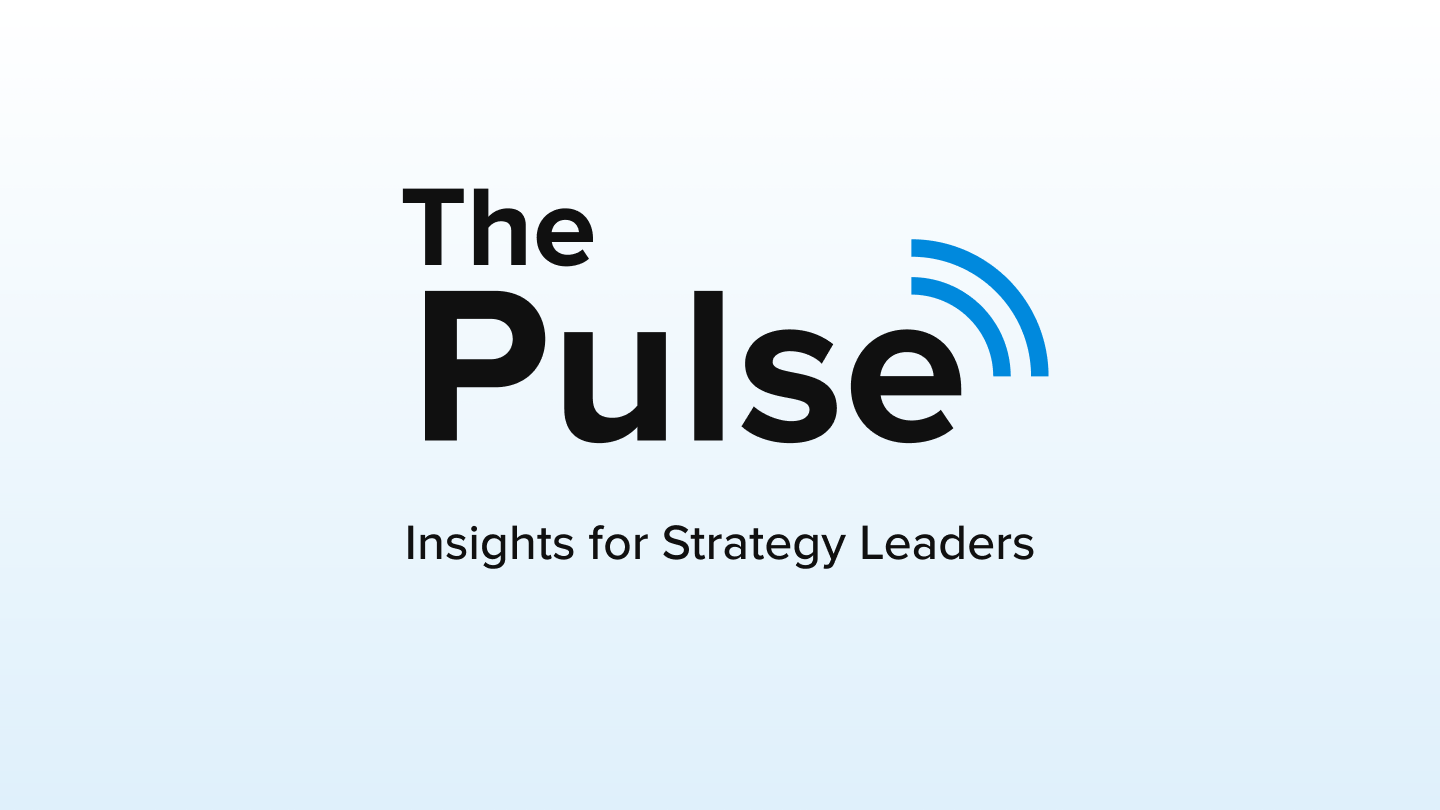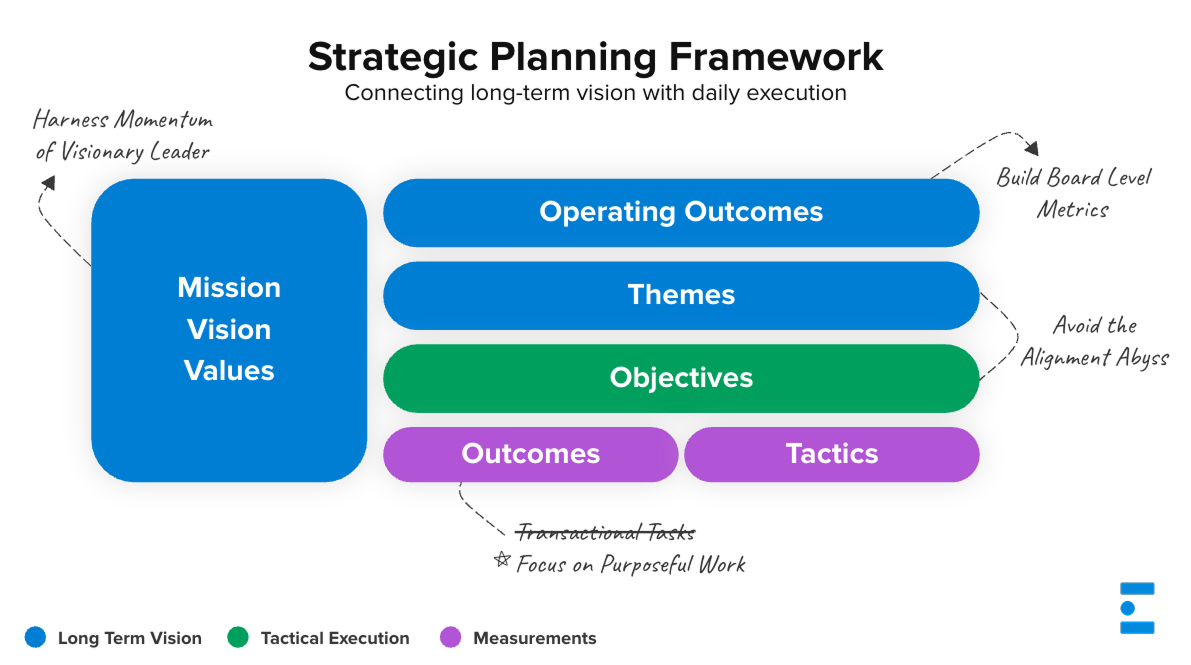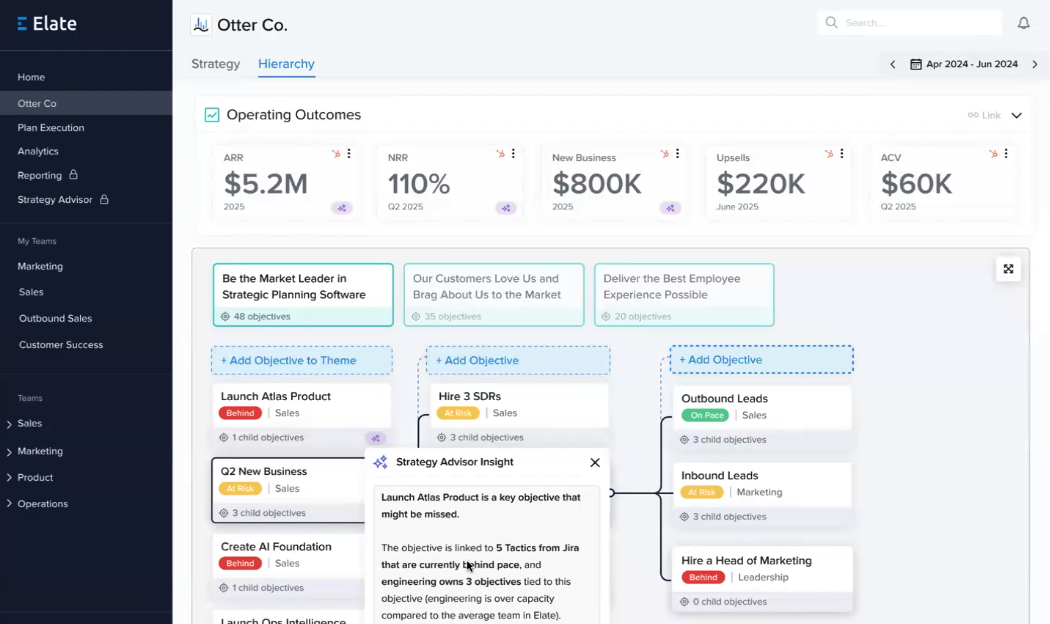
Welcome to the 45th edition of The Pulse, your bi-weekly newsletter of Insights for Strategy Leaders. Elate is a strategy execution platform that helps strategy, operations, and chief of staff leaders align teams, execute plans, and see real results—without the chaos of disconnected tools. Learn more at goelate.com.
In this edition:
- 🔢 Operating Outcomes: How to Set Them + Why They're Important
- 🎥 Higher Ed Panel Recording + Takeaways
- 🔦 Customer Spotlight: Camden County College
- 🍿 Strategy Snack: Saying "No" to Activity Not Driving Impact
- ➡️ Subscribe via Email ⬅️ And catch up on previous editions
Let's jump in.
Strategy Leaders don’t need to be sold on the idea of Strategic Planning.
One of the best parts of the work we do at Elate is the opportunity to work with organizations across nearly every industry. From professional sports teams and high-growth AI companies to higher ed institutions and manufacturers, we’ve seen thousands of strategic plans that span a wide spectrum. 🌐
Yet around this time of year, we frequently see the momentum of strategic planning start to fade. The dog days of summer can create drag, even for the most committed teams.
And I often hear the same question from leaders:
“How do I keep my executive team focused on the execution of the strategy we spent so much time creating?”
The answer to this is by revisiting the purpose of the strategy itself.
At Elate, we believe the ultimate impact of strategic planning executed well is creating a real connection between your long-term vision and day-to-day execution.
What Does That Actually Look Like?
Put simply, it means translating the operating plan your executive team presented to the board into something tangible for employees. It means communicating that plan clearly and aligning your teams’ work to it.
Doing this well requires a shift in mindset. From transactional tasks to purposeful work. A culture measured by impact, not activity.
Of course, that’s easier said than done.
But in our experience, there’s one change that makes a major difference. One that creates a foundation for that cultural shift.
And it starts with defining your Operating Outcomes. 💪
What Are Operating Outcomes?
Operating Outcomes are the key measures of success that determine whether your organization is executing effectively against its operating plan. The metrics by which the ultimate success and health of the organization is measured.

For many organizations they include metrics like:
- Revenue targets
- Fundraising goals
- Customer retention
- EBITDA
- Gross margin
- Student enrollment
These are health indicators. They should be clear, measurable, and directly shape both how your strategy is built and how it’s executed.
Most organizations have no more than five. (Though I know the temptation to squeeze in a sixth…)
In drinking our own champagne, we have four at Elate:
- ARR
- New Business Growth
- Customer Expansion
- Customer Retention
Why Do Operating Outcomes Matter?
You probably don’t need convincing that these metrics are important. But here’s where many organizations fall short:
They treat Operating Outcomes as executive-only information. 🤐
Yes, some data is sensitive (e.g. cash on hand). But when you shield these metrics from your teams, you miss the opportunity to empower them to align their focus and priorities to your organization’s overall strategy.
Employees need clarity on what success looks like. 💡 When they understand the Outcomes that matter most, they can shape their Objectives to support them. They can measure their work on impact, not the quantity of output.
This helps eliminate confusion and priority fatigue. It gives teams a shared scorecard and a clear path for contribution.
Take this example:
We worked with an organization that was focused on new logo growth. It was a key lever for their new business target and fed directly into their strong upsell motion. Thus, their operating plan depended on hitting a certain number of new logos added, because it was how they were forecasting their customer expansion goals.
But they didn’t communicate the importance of adding a specific number of new logos. They only shared the new business target.
They hit that goal thanks to one massive customer, but missed their upsell targets in the quarters that followed. Why? They hadn’t built enough new customer relationships to drive upsell opportunities.
Employees weren’t focused on new logos because no one shared that it mattered.
Operating Outcomes Help Identify Risk
We’ve worked with plenty of organizations that have scar tissue created from failed rollouts of OKRs, EOS, or other operating frameworks.
Most strategy leaders still believe in the principles behind those frameworks and the power they have to unlock alignment and execution.
But the breakdown often comes when the outcomes the organization cares about aren’t communicated clearly from the start. 🔏
When employees understand the outcomes that matter, they’re empowered to build meaningful objectives and prioritize accordingly.
Operating Outcomes give them a true north. ⭐

And this is where the strategy leader’s vision becomes real.
When outcomes are aligned to the operating plan and tied to objectives, you gain visibility. You can spot misalignment and surface risk.

You’ve mapped your strategy. Now you can monitor the signals that threaten it.
Without Operating Outcomes, OKRs, Rocks, or Initiatives are often created in a vacuum without connection. Teams work hard… but not together.
It's Never Too Late to Start Sharing
Whether you’re halfway through your year or preparing to kick off a new one, it’s not too late to share your Operating Outcomes with your teams.
Doing so can align your teams around what matters most and create momentum for the second half of the year. It’s also one of the best ways to spark ✨ cross-department collaboration and clarity.
If you’re looking for help defining or rolling out your Operating Outcomes, we’d love to chat. Feel free to reach out to me or anyone on our team. We’re always happy to share what’s worked.

🎓 Takeaways + Recording from Higher Ed Panel
We recently sat down with strategy leaders from institutions across North America to talk through how they’re navigating strategic planning in higher education.
From aligning long-term vision with day-to-day execution to building cross-campus momentum, it was packed with practical takeaways that can be applied across all sectors.
👀 Click here to watch the recording
📩 Click here to download a PDF with the 5 biggest takeaways
We also have a playlist on Youtube with so many great snippets from the panel as well as previous sessions. Click here to view the Strategy Snacks playlist.
💫 How Camden County College Brought Their Strategic Plan to Life
For those interested in how organizations are using Elate, I want to highlight Camden County College's journey from a manual, reactive planning process to a collaborative, dynamic approach that spans across the entire institution.
“When a plan lives in Excel, it’s static,” Jocelyn shared. "There’s no room to ask questions, collaborate, or lean into areas of opportunity."
Click here to read more about Camden County's journey
💥 How Strategy Leaders Say "No" to Activity Not Driving Impact
A great clip from the panel on how strategy leaders think about prioritization when it comes to new initiatives.
That's it for today, have a great rest of your week. And let me know if this resonated or what is top of mind for you right now.
- Brooks


